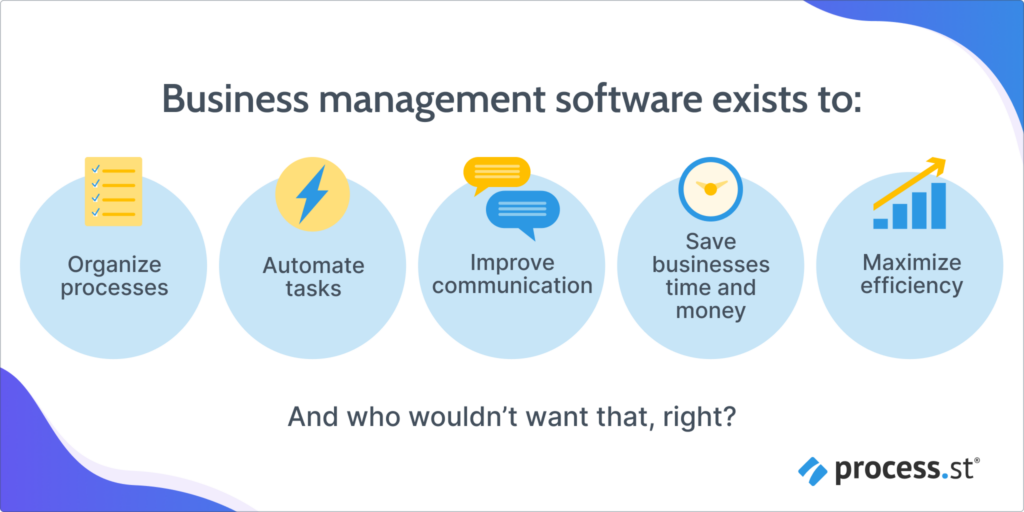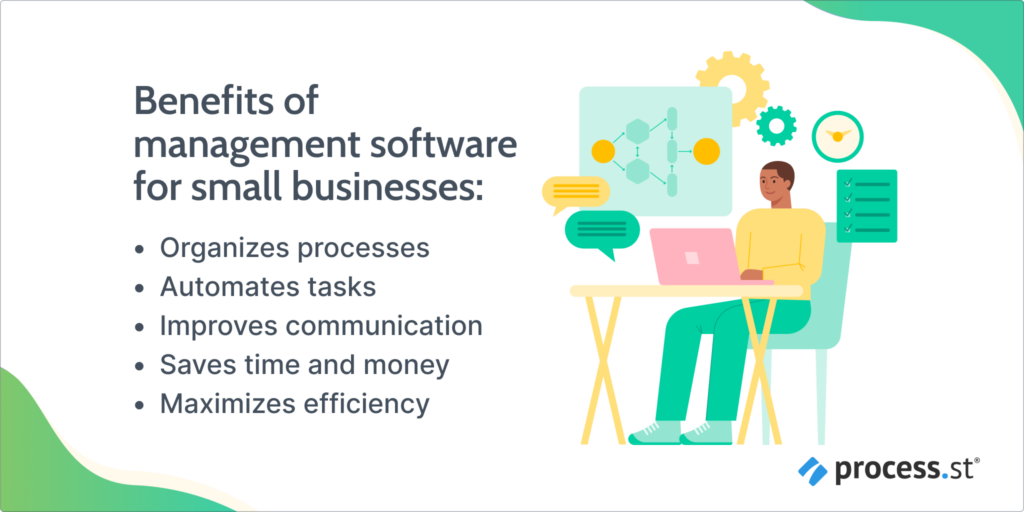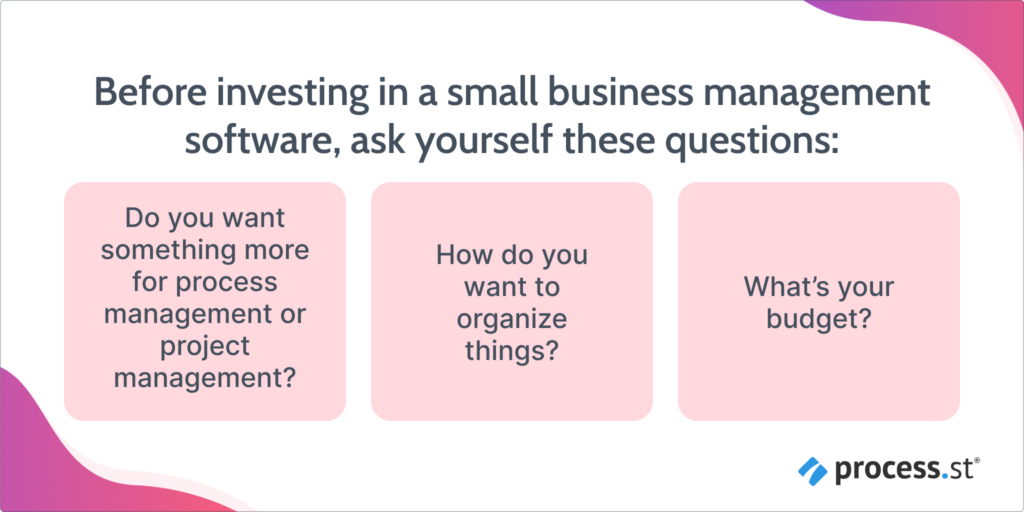Get started quickly, see results immediately, no code needed.
The Best Small Business Management Software You Need To Streamline Your Day
Small business management software is essential for small businesses that lack the resources of larger counterparts.
Often things that are helpful to companies are too expensive for small businesses, which can put them at a disadvantage.
But one thing small businesses can, and should, use just the same as any large company is business management software.
Let’s talk all about business management, why it’s important, how it can help, and what the best software solutions for small businesses are.
What is business management software?

Business management software goes by several names. You may hear it called business process management software or business operations management software.
And while I could be pedantic and explain the subtle differences between all three names, I’ll spare you. Truthfully, they all perform the same basic function: They keep businesses running smoothly.
Business management software exists to:
- Organize processes
- Automate tasks
- Improve communication
- Save businesses time and money
- Maximize efficiency
And who wouldn’t want that, right?
The best small business management software
1. Process Street: Best for recurring processes
Process Street specializes in making recurring processes seamless and easy for businesses large and small. With it, you can make checklists that can be automated to make everyone’s lives easier and take boring, repetitive work off of employees’ plates.
It differs from project management software because it keeps all the long-term information about company processes in one place. It keeps things organized and standardizes everyday business practices, which can save businesses lots of time and money.
This software gives you the ability to invite anyone to collaborate on a workflow, whether they work in-house or not. It keeps each step of every process organized.
Using integrations with third-party apps such as Zapier, Salesforce, and Slack to automate the workflow, Process Street keeps everything in one place.
Integrations like that really help to streamline operations and make sure nothing falls through the cracks. It also provides lots of free workflow templates to help users get started.
Process Street’s pricing starts at $1,000/year for the most basic package which allows five members and 10 guests, perfect for small businesses.
They offer two other packages called Pro and Enterprise, which start at $5,000 and $20,000 per year respectively. However, it should be emphasized that’s where the pricing starts, it’s a custom price for each client to suit their specific needs.
2. Asana: Best tool for managing deadlines
Asana is great for project management and has multiple ways you can view a project, like:
- Kanban
- Calendar
- List
- Spreadsheet
But it has one extra that sets it apart from other tools: timeline.
The timeline feature gives users a visual representation of the stages of each project from start to finish and helps teams keep track of their deadlines.
Asana also comes with a unique workflow management feature that allows managers to see the overall workload of each team member. It tells managers who is overworked, underworked, or if a project is properly staffed. Features like this save employees from burnout.
One of the best features of Asana is its pricing.
For teams of 15 people or less, Asana is free forever on the Basic plan. What’s even better is that Asana doesn’t limit many features on this plan. You’re also not limited on storage or the number of projects either. The biggest drawback to this plan is that it doesn’t come with the timeline view.
The next level is the Premium plan, which is $10.99 per user per month. With unlimited features, it’s ideal for mid-sized companies that want better project management. Asana Premium also unlocks the timeline feature, which is one of its biggest perks.
Lastly, there’s Asana Business, which is priced at $24.99 per user per month. This level includes exclusive tools, like the workflow feature, approvals, and advanced reporting.
3. Trello: Best budget-friendly tool
Trello is a Kanban-style project management tool that is the digital answer to sticky notes on a wall.
In my previous job as a remote project manager for a small business, I used Trello to manage multiple projects at once to great success. It’s a great way to collaborate and have all the steps of the project clearly laid out and defined.
You can see what your colleagues have done or are currently working on in real-time, making it easier to know the status of your project without having to wait for replies from someone in another time zone.
Additionally, Trello allows you to:
- Set due dates
- Add subtasks
- Automate recurring tasks
- Communicate directly with collaborators
It’s intuitive and very easy for teams to learn how to use it. You could have your team using it reliably within a week.
Trello has a Free plan that allows you 10 boards, unlimited cards, and unlimited storage (but only 10MB files). If you have less than 10 projects and are on a budget, this is a great option.
The next plan Trello offers is the Standard, priced at $5 per user per month. It gives users unlimited boards and storage with files up to 250 MB.
Then there is the Premium plan for $10 per user per month. It includes everything the first two plans have, plus unlimited file sizes and different views, including calendars, timelines, and even a map.
Finally, there’s the Enterprise plan for $17.50 per user per month. This plan offers permissions features and unlimited integrations with available third-party apps.
4. Notion: Best for knowledge management
Notion is a business management software that focuses on knowledge.
What does that mean? Well, Notion’s biggest selling point is that you can use it to:
- Take notes
- Create rich documents
- Create wikis
- Outline tasks
It’s about putting all of the knowledge contained in a project into one place.
For example, I once had a job writing scripts for a YouTube channel. We used Notion to upload the prompts, scripts, descriptions, and thumbnails. We even used it to leave notes on each other’s work.
The scripts didn’t have to be uploaded to Notion as separate files, they could be put in directly without sacrificing any rich text.
Notion won’t be able to give you detailed reporting and analytics on data like other tools, but it’s excellent for creative collaboration.
It also includes administrative features for permissions management, checklists, and real-time collaboration.
For small teams of five or fewer people, Notion is free under the Free plan with the ability to integrate with Slack and GitHub and invite up to 10 guests to collaborate.
Then they offer the Plus plan at $8 per user per month. It gives users the ability to invite up to 100 guests and upload unlimited files.
After that, they have the Business plan, which offers private team spaces and 250 guests for $15 per user per month.
Finally, they offer their Enterprise plan. There is no set price for this, you need to get in contact with them to receive a quote. It features a custom number of guests, unlimited page history, and advanced security.
5. Monday.com: Best for different management styles
Monday is the most versatile software for project management.
Monday.com utilizes very user-friendly timelines and calendars to structure tasks, giving users a clear picture of when things should be completed.
You can also change the view to see the project tasks laid out in a Kanban or Gantt chart.
Monday gives project managers a lot of flexibility in their methodologies, whether they prefer Agile or Scrum.
Monday supports lots of different types of workflows that can be used by most departments.
These workflows include:
- Customer relationship management (CRM)
- Software development
- Marketing
- Human resources
- Sales
Monday.com’s pricing has five levels to it. The lowest level is the Individual plan which is free and allows two users and up to three boards.
Then there’s the Basic plan, which costs $8 per user per month but only gets you 5GB of storage.
After that, they have the Standard plan at $10 per user per month, which is the most popular plan.
The last two plans are the Pro and Enterprise plans. The Pro plan is $16 per user per month, but you need to contact support to get a quote for the Enterprise plan.
The big difference between the plans is that Enterprise is HIPPA compliant and has features not offered by the others, like reporting and analytics.
Benefits of management software for small businesses

Let’s break down that list above.
Organizes processes
Every business management software organizes things a little differently, which is great because you’ll be able to find the perfect method for organizing your small business.
Organization generally comes in the form of:
- Checklists
- Kanban
- Calendars
- Spreadsheets
Or sometimes more than one. You can put all of your process tasks in one place along with due dates, documents, and deliverables.
By having everything you need to keep operations running as smoothly as possible in one place that your whole team has access to, your business will be the most organized it’s ever been.
Automates tasks
Automation is probably one of the best features of business management software.
When it comes to recurring processes, there are often a lot of tedious tasks to get done that take up people’s time. Things like sending emails, inputting data, and analyzing metrics. You know, the stuff most of us hate doing.
But with business management software you can automate those tasks and more, freeing up your team’s time to do more high-value work like managing customer relationships.
Automation doesn’t replace employees. It works with them to make their jobs easier and more enjoyable.
Improves communication
With features like:
- Role assignments
- Approvals
- Comments
- Chat boxes
Business management software does a lot for improving communication in a small business. It makes it easy to know who is responsible for what and to shoot someone a message if you have any questions.
And when your team communicates well, they will be able to work with each other more seamlessly, increasing productivity.
Saves businesses time and money
With the ability to organize processes, automate tasks, and improve communication, saving time and money is a natural consequence.
Being able to reduce costs is essential for the survival of small businesses, so while most business management software comes at a cost, it’s a small price to pay for the overall savings it brings.
Time is money, right? So saving time = saving money. Basic math that even a writer like myself can do.
Maximizes efficiency
This ties back to saving time. Since the software can do some of the backend work for you, that frees up a lot of time.
Time you can use to increase production and sales, create lasting customer relationships, or ramp up your marketing campaigns. That kind of efficiency is worth so much more to small businesses, so you would be crazy not to get business management software.
Challenges of business management software

One of the biggest challenges of business management software is finding the right software for your small business.
Do you want something more for process management or project management? How do you want to organize things? What’s your budget?
These are questions you need to answer before you start shopping. To help you get started, let me explain the difference between process and project management.
Projects are short-term and measurable. There is a clear beginning and end to a project. There may be a budget and specific deadlines that must be met, and you may only ever work on a specific project one time.
Processes are recurring tasks that keep day-to-day operations running smoothly. Processes are things like:
- Employee and client onboarding
- Customer lifecycle management
- Sales
- Product development
- Accounting and invoicing
You get the idea. It’s literally impossible to run a business without some kind of process management. But, if your business does a lot of short-term projects, then you may want a project management software.
One final thing about small business management software!
All of the software we talked about offer either demos or free trials or both. I recommend you take advantage of them to figure out which one is best for your business.
Don’t just settle for the first one that sounds good, play around with them and involve your team to find the best one to suit your needs and make your small business thrive.







 Workflows
Workflows Projects
Projects Data Sets
Data Sets Forms
Forms Pages
Pages Automations
Automations Analytics
Analytics Apps
Apps Integrations
Integrations
 Property management
Property management
 Human resources
Human resources
 Customer management
Customer management
 Information technology
Information technology


